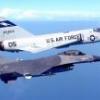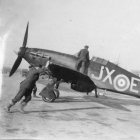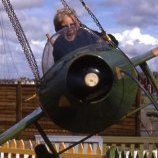-
Posts
873 -
Joined
-
Last visited
Profile Information
-
Gender
Male
-
Location
Salisbury
Recent Profile Visitors
2,536 profile views
224 Peter's Achievements

Obsessed Member (4/9)
2.2k
Reputation
-
The cockpit is close to being finished, here it is from above: note the absence of a seat, this goes in once the wings and fuselage are joined... The aluminium floor pads are floorboards, the rudder bar and control column will go in before the wing is glued to the fuselage. A closer look at the port side...showing the engine controls It all looks impressive, but I'm not sure how accurate it is when compared with the replica being built as detailed in the video earlier in this story...
- 16 replies
-
- 5
-

-
- 1/32 Scale
- Special Hobby kit
-
(and 1 more)
Tagged with:
-
Sunday Confusion. I'm making progress, but thought it would be "fun" to describe some of the challenges that it instructions bring to the workbench....For example ehe cockpit seems to evolve through the build, it starts with step 1 but isn’t finished until step 66. Along the way considerable care is needed to avoid difficult to correct errors that the less than clear instructions can lead the unwary into, these are some of the worst… Step 6 covers the assembly of the flare tubes and step 7 their “fitting’ behind the seat bulkhead. I say fitting but it is more like hoping for the best. There is a lug on the tube that locates into a slot on the underside of Part H4. But the other end has no such assistance. On the underside of the fuselage is the marking for the flare tube door, but working out how to align the second tube in step 9 is essentially guesswork and it has to match up with the flap in part A2 so that when the two fuselage halves are joined in step 39… until then it sort of hangs in space with a bit of help from bulkhead G22…I used a bit of stretched sprue to secure the end. Step 10 brings us to the instrument panel. The first 54 machines, up to P6983 have a very different cockpit layout. There is a note next to step 10 drawings, commenting that a choice has to be made in step 10 and 14. What it doesn’t say that Steps 12 and 14 are not needed and for later machines and the builder has to go directly to step 15. Steps 16,17 and 19 involve the identification of some VERY small parts and the lack of clear location points for most just adds to the joy. Building the nacelle bulkheads starts with step 32 and after the challenge of the cockpit it seems easy, but fitting steps 33 and 34 into the respective nacelles is a challenge and there are two tiny brackets on the lower edge of G3 and G23 that step 37 reveals to be the main mounts for the U/C legs….I hope they are strong enough. Epoxy at this point, I think. Talking of assembling thee nacelles step 35 shows one nacelle side with a knife blade symbol, or possibly a drill, and with NO explanation….just a small point of green identifying a little lug on the aft part of the U/C well edge: the implication is that it needs removing. I left it as it would be very easy to remove when fitting the U/C doors in step 60. These examples are just a sample of the eccentricities of the kit. The way the instructions are laid out seems designed to confuse the builder by bouncing from one stage to another and not making clear why….. In the next post I will include photos of the completed cockpit, and joining of the fuselage halves to each other...!!
- 16 replies
-
- 1/32 Scale
- Special Hobby kit
-
(and 1 more)
Tagged with:
-
Another Friday Update... The wings and nacelles are together and the fuselage taped up to see what it will look like. It is BIG, a 1/32 Spitfire for comparison...... Takeaways from this week.... 1. A lot of filling and sanding will be needed because of the lack of precision in the joints between major parts. 2. Read the instructions, not just the stage you are working on, but the next stage in which that stage will be used. 3. Test fit wherever possible, a lot of fettling is needed to get joints just so. The propellor hubs are a case in point, there is a short shot on the aft half which means the front half has to be trimmed. 4. Read references, Neil Robinson's book is invaluable. Some gaps and "mis alignments are as the A/C was.... https://www.scalemates.com/books/westland-whirlwind-wingleader-photo-archive-19-neil-robinson--137536 The radiator flaps (not yet fitted) have a small gap at the trailing edge and are moved only with the flaps, which are not adjustable!!! 5. Glue twice, both Revell and Tamiya Thin glues don't soften the polystyrene well, scraping off paint is essential. This will be spectacular, but it has proved to need many almost forgotten modelling skills. This kit is more like a short run kit from the 1970s....Modern (Airfix, Revel, Tamiya etc) tool making spoils us!
- 16 replies
-
- 3
-

-
- 1/32 Scale
- Special Hobby kit
-
(and 1 more)
Tagged with:
-
Here is the interior of the wing roots, showing the spars and radiators. Nicely detailed, buy why? Once the upper and lower winfs are hoined everything will be all but invisible! The instructions suggest that all this structure should be interior green, but this is incorrect, only the cockpit is interior green. Once the wing halves are joined the next task is to assemble the engine nacelles and fit them to the lower wing, most unusual. As mentioned previously, the lack of locating pins makes everything "real modelling", measure and test fit before gluing. Getting the tail planes assembled was a challenge with quite a bit of checking and then sanding down once the glue is dry. Once the wing and nacelles are assembled the cockpit can be completed and after that the fusilage halves joined and fitted to the wing...!
- 16 replies
-
- 4
-

-
- 1/32 Scale
- Special Hobby kit
-
(and 1 more)
Tagged with:
-
Well not the completed cockpit.....but progress. . There is a mass of VERY small parts, scattered across the sprue frames and instructions that are vague, not forgetting a virtual absence of locating points. To position the instrument panel I had to tape the two fuselage halves together and then position the panel in from the underside....the floor fits to the top surface of the wing , followed by the seat. Still a lot of parts to fit, and paint. Most of the "bits" are. black or silver......Not really sure where some of the bits go! Fitting the fuselage halves together showed the poor fit, caused my micro locating lugs: a lot of testing and gluing in sections will be needed. The next report will focus on the wing and nacelles: there is copious radiator detail, but it is all but invisible. The logic of the toolmaker and designer at Special Hobby escapes me, they have produced a challenging model!
- 16 replies
-
- 9
-

-
- 1/32 Scale
- Special Hobby kit
-
(and 1 more)
Tagged with:
-
Some work done on the cockpit, it is slow and difficult as the tool designer has allowed obsessive detail to run away and overtake ease of construction: too many small parts and too few positive locating points. The cockpit side modules are made up of lots of parts when such parts would normally be expected to be one block. Fitting the flare tubes is a challenge, it is only by referencing the tube covers on the under side is it possible to position them, there are no location lugs or anything. The instrument panel is well moulded and the transfers look good, up to the point that you try to apply them: they are thick and not flexible, thank goodness for Microset. Further, there is no clear location point for the panel.... Anyone bought up on early Frog kits will feel at home.... especially as the two fuselage halves have only a handful of tiny location pins. Photos of the completed cockpit to follow....
- 16 replies
-
- 1/32 Scale
- Special Hobby kit
-
(and 1 more)
Tagged with:
-
224 Peter started following RAF Vampire FB 9 , Revell’s 1/32 Scale Mosquito B.IV and Westland Whirlwind 1
-
Revell’s 1/32 Scale Mosquito B.IV
224 Peter replied to Max Headroom's topic in Work in Progress - Aircraft
Back in 1973, when I was but a callow youth, I built this kit. Without any references, other than imagination, (Back then it was all we had) I cut out the bomb bay doors, fitted a roof and a couple of bombs. The cockpit is exactly as Rvell supplied it, because I knew no better. The model still sits, it looks like a B IV Mosquito..... sort of. The big 1/24th Airfix kit waits... So OP, what happened? Peter -
I cut circles of lead flashing and stuck them behind the armour plate seat nack, from memory 5 discs and it is a comfortable nose sitter. I do wonder if Airfix will release a. trainer version....would be good.
- 6 replies
-
- 1
-

-
- DH Vampire FB 9
- RAF Auxillary Airforce
-
(and 1 more)
Tagged with:
-
The LSP thread is fascinating, a 1/32nd scale Whirlwind group build! BUT more importantly, it is clear from the wreckage that the internals, other than the cockpit and forward fuselage, were painted silver. So, that is what I'll follow. Spraying silver is fun...!
- 16 replies
-
- 2
-

-
- 1/32 Scale
- Special Hobby kit
-
(and 1 more)
Tagged with:
-
Agreed that the fire extinguisher should be brass Underside colours were fluid in the early years, Neil Robinsons book is helpful..... https://wingleader.co.uk/books/westlandwhirlwindwpa19/ The same A/C could have a number of undersurface colours until the grey/green/grey colours arrived. As to wing interior...bits open to the air like the upper einf where it acted as the cockpit floor and the radiator ducting would probably have been cockpit green, other interior bits like the wheel wells could have been silver. More photo inspection needed, I think.
- 16 replies
-
- 1/32 Scale
- Special Hobby kit
-
(and 1 more)
Tagged with:
-
Time to return to 1/32nd scale.... Am impressive kit, finely moulded in a hardish grey plastic. Why build a model of an aircraft that was built in small numbers and didn't last much beyond 1944? Because it somehow captivated me ever since I built the old Airfix Kit back in my youth. The originals were built locally in Yeoville and but for the non availability of Rolls Royce Peregrine engines it might have been in service before the war started: with a pair of Merlins it might have been as good as the DH Hornet. This project has also been a source of inspiration... https://www.whirlwindfp.org/ Another 1:1 scale kit. The videos are all worth watching. On with the build! The instructions are clear...to a point. They assume the modeler has a degree of knowledge and experience. The cockpit is the start..... There are very few positive location points and great care is needed, as in step 4 where the two bulkheads have to be glued into the fuselage before much else goes in. Looking at the cockpit of the actual aircraft the layout is chaotic, with instruments here and there. The moral has to be test fit, sand if needed and test again! The paint is Tamyia interior green, it mat be a bit dark when compared with the paint used on the replica..... The project's website has many videos, No 14 is particularly good at this stage as it details the cockpit fit out. More over the next few weeks...!
- 16 replies
-
- 15
-

-
- 1/32 Scale
- Special Hobby kit
-
(and 1 more)
Tagged with:
-
The Rest.... First, Armed.... 8 x HE rockets, double mounted plus 2 x 250lb bombs, so no room for drop tanks. The result was a significantly reduced range.....! From above, rear quarter.... And finally... That is the end of my vampire adventures... Yes, I have not applied all the small stencil markings and warnings, life is too short... Comments, even brutally honest ones, welcomed. I shall never build different iterations of the same kit.....
- 6 replies
-
- 18
-

-
- DH Vampire FB 9
- RAF Auxillary Airforce
-
(and 1 more)
Tagged with:
-
This is the story of DH Vampire FB9, of 502 Ulster Squadron Royal Auxiliary Air Force Squadron, based at RAF Aldergrove in the 1950s. In this photo she is sitting in front of a DH Vampire F3 and DH Vampire F1.. The F3 is built straight from the box, as is the FB9, but the F1 is a conversion, reported on here last year. This thread describes the build... It also contains a link to the F1 and F3 builds. The main reason for building the FB9 was to exhibit the bomb and rocket load that the FB 9 could, in theory, carry. More photos. in the next post...
- 6 replies
-
- 18
-

-

-
- DH Vampire FB 9
- RAF Auxillary Airforce
-
(and 1 more)
Tagged with:
-
OK, a picture always trumps memory.....😇 II will leave it as it is...in the photo above: yes, Hu 74 is a very good match for the primer in the photo. But because I'm making a model of an aircraft as it is NOW, not how it was built I'm still uncertain, mostly because the 2023 photos in the Yeovilton workshop suggest silver or sky.....a repaint of the wheel wells cannot be ruled out. Thanks all for your sage advice: time to stop digging and get some transfers on!
- 9 replies
-
- 1/48 Airfix
- FAA
-
(and 1 more)
Tagged with:
-
OK, legs and doors resprayed.....in sky! Wheels on and exhausts painted...... I'm still not happy with the "gold yellow, AKA Linen" Searching the web for photos of the Sea Fury and Tempest 2 wheel wells none have that colour visible, it is wither undersurface colour, light grey or dull silver. I've also spoken to 2 people who worked at Hawkers in the 1960s and they don't recall a yellow Linen colour. SO....I'm going to spray the wheel wells dull silver.
- 9 replies
-
- 2
-

-
- 1/48 Airfix
- FAA
-
(and 1 more)
Tagged with:





